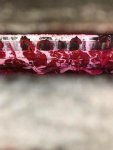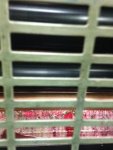Revolutions
Member
Dear all,
I recently discovered this forum and base for plenty of very usefull topics.
When the problem excists and the solvetion is not near I must ask do you have issues with Sonora X plates DOP?
DOP topic is manny times talked about but still I need yours overview on the specific situation.
What I've tried to do is elimination process on what causes poor DOP on two presses in the nearly same level.
The presser are KBA 105-4 & Heidelberg SM 102-4:
1) The same for both of them is:
- Ink Kingswood Globby-ISO shades conventional,
- Water - tap water (14 odH)
- Blankets - ContiAir,
- Prepress equipment - Kodak platesetter.
- IPA supplier & ammount (KBA 9%, HD 7,5%),
- Dampening solution is changing every 10 working days on both presses
2) Differences:
- Pressman,
- Jobs ( coated, uncoated papers, book papers, runlenght)
- Dampening mixture ( KBA - Böttcher Fount 3010+, HD - Saphira Low chem 510),
- pH values - KBA 5,12 ; HD - 5,28
- Conductivity ( KBA 930 micS, HD 1138 micS ),
When DOP with "standard" amount of dampening solution (4 pre dampening revolution) both presses need at least 60-80 sheets to completeally DOP and magenta is struggling the most.
When DOP with aditional manual - button press (few times) dampening with dampening plate rollers before the inking rollers pushed down still we have 35-45 sheets to complete DOP, thats too much!
Do you have any idea whats going on? My ideas perished when I tried with other ink producer (J+S Multiboard shade).
I've checked the temperature of dampening mixture both are 10 oC, in Baldwin/Technotrans systems.
Rollers water chilling system turned on to 25,5 oC.
When switched back to Sonora XP - Standard DOP more/less 20 - 25 sheets needed depending on ink surface coverage on the plate.
Mr. Alois sir, please comment, others you are welcome also.
Thank you in advance!
Best regards,
Milan
In trouble
I recently discovered this forum and base for plenty of very usefull topics.
When the problem excists and the solvetion is not near I must ask do you have issues with Sonora X plates DOP?
DOP topic is manny times talked about but still I need yours overview on the specific situation.
What I've tried to do is elimination process on what causes poor DOP on two presses in the nearly same level.
The presser are KBA 105-4 & Heidelberg SM 102-4:
1) The same for both of them is:
- Ink Kingswood Globby-ISO shades conventional,
- Water - tap water (14 odH)
- Blankets - ContiAir,
- Prepress equipment - Kodak platesetter.
- IPA supplier & ammount (KBA 9%, HD 7,5%),
- Dampening solution is changing every 10 working days on both presses
2) Differences:
- Pressman,
- Jobs ( coated, uncoated papers, book papers, runlenght)
- Dampening mixture ( KBA - Böttcher Fount 3010+, HD - Saphira Low chem 510),
- pH values - KBA 5,12 ; HD - 5,28
- Conductivity ( KBA 930 micS, HD 1138 micS ),
When DOP with "standard" amount of dampening solution (4 pre dampening revolution) both presses need at least 60-80 sheets to completeally DOP and magenta is struggling the most.
When DOP with aditional manual - button press (few times) dampening with dampening plate rollers before the inking rollers pushed down still we have 35-45 sheets to complete DOP, thats too much!
Do you have any idea whats going on? My ideas perished when I tried with other ink producer (J+S Multiboard shade).
I've checked the temperature of dampening mixture both are 10 oC, in Baldwin/Technotrans systems.
Rollers water chilling system turned on to 25,5 oC.
When switched back to Sonora XP - Standard DOP more/less 20 - 25 sheets needed depending on ink surface coverage on the plate.
Mr. Alois sir, please comment, others you are welcome also.
Thank you in advance!
Best regards,
Milan
In trouble













